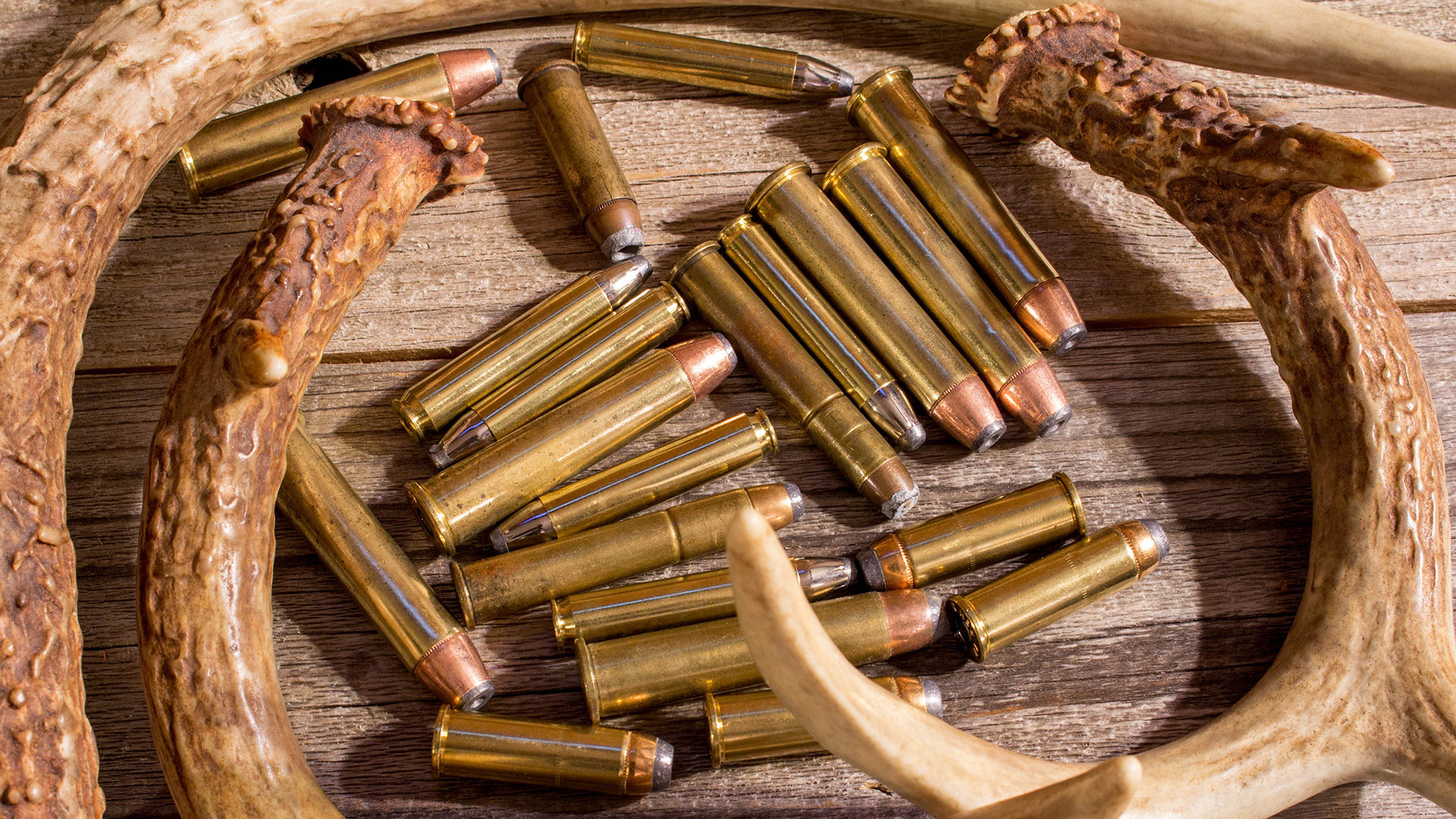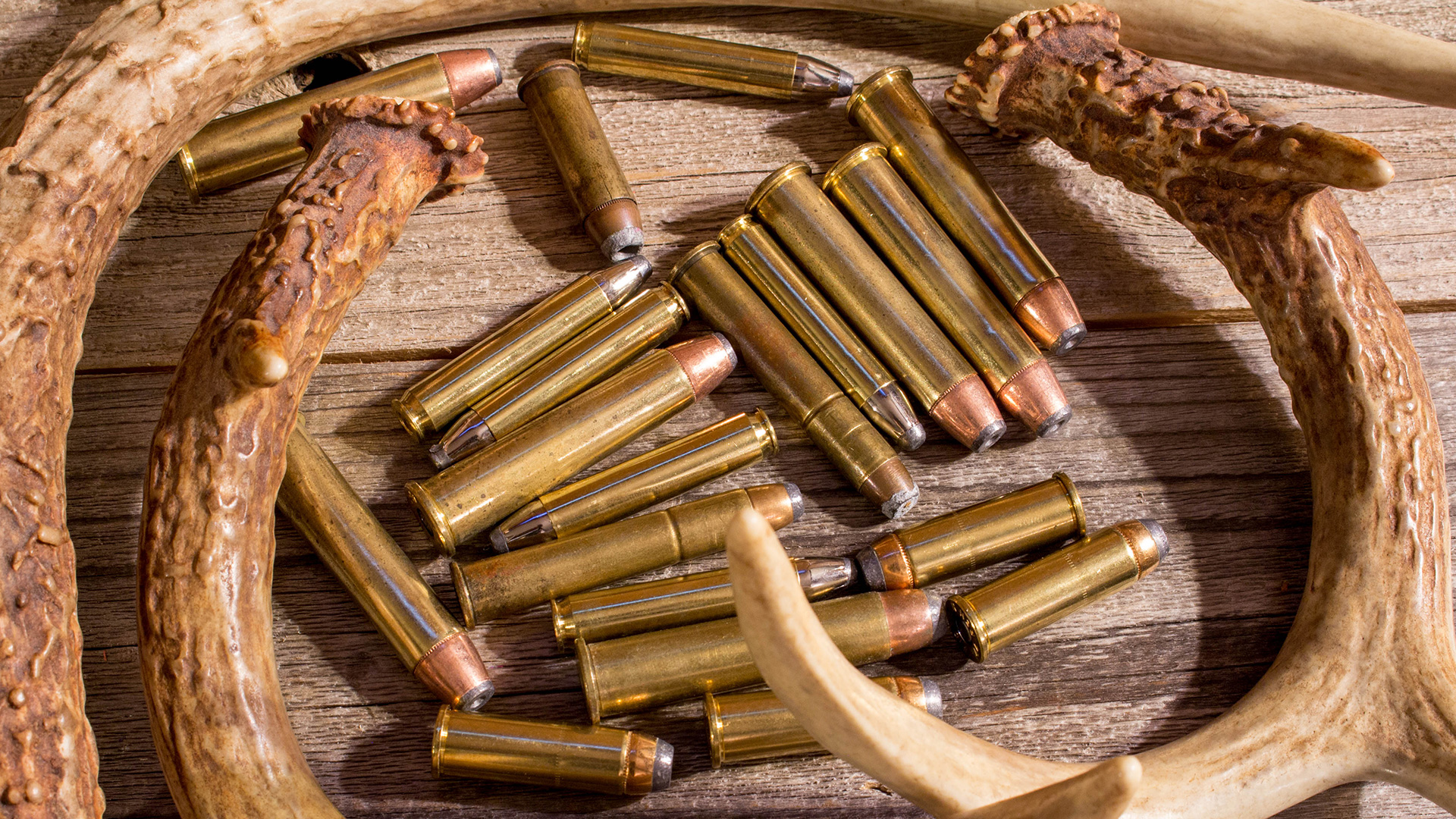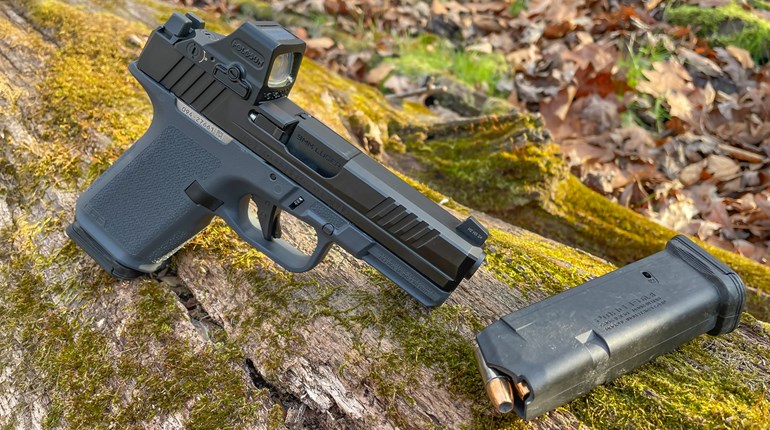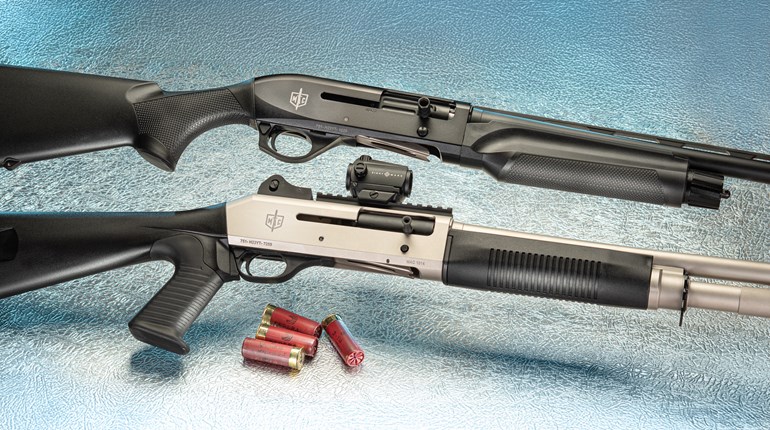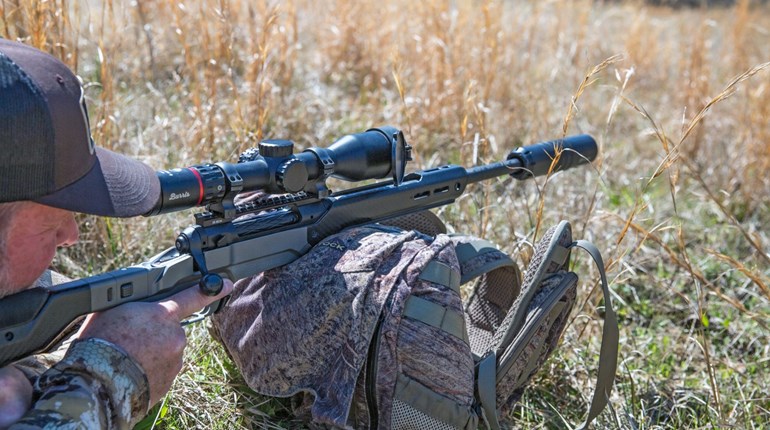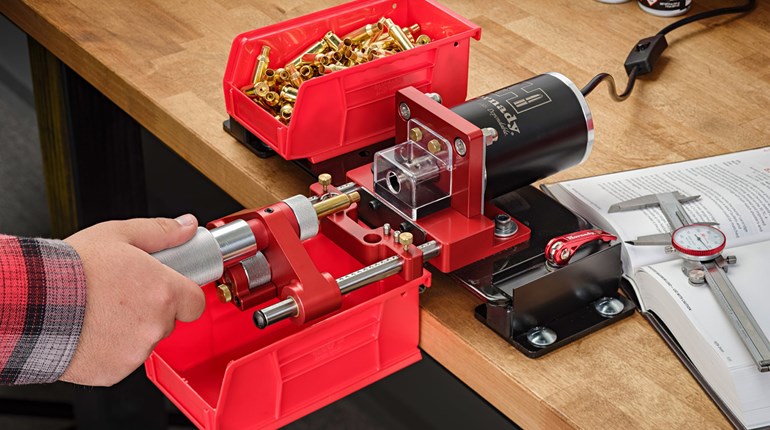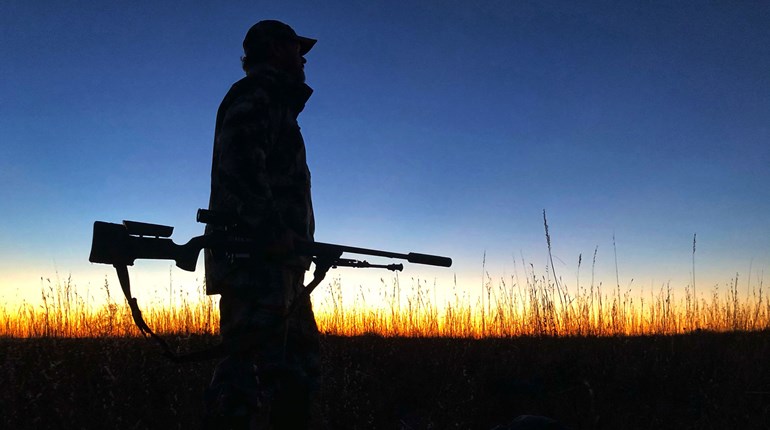
You know the feeling. As legal hunting hours wind down, sadness sets in. The so-called “perfect plan” proved to be anything but, and your mind wanders at what “could have been” if you were elsewhere. But you’re not.
With 10 minutes remaining, I began to slowly gather the items spread around me—binocular, rangefinder, cartridge holder with three fewer cartridges, and various articles of clothing that I’d either shed or brought to increase my comfort. With light fading, along with my hopes of seeing a deer, I caught movement to my left.
Emerging from a finger of trees and tangles that juts into the large cornfield in which I was sitting, was a big-bodied deer. Frenziedly grabbing my Nikon binocular, I confirmed that it was indeed a buck, and one that was deserving of my final Virginia either-sex deer tag. Paralleling me at 174 yds., he walked briskly to mid field, then did an abrupt about-face. I examined my watch. Seven minutes. Quickly, yet stealthily, I moved into the prone position and then eased my .308 Winchester-chambered rifle to face the buck, which was unaware of my location or his predicament.
With seconds ticking, I eagerly awaited for the buck to emerge from behind a small knoll, and in short time it did. When the first acceptable shot, a slight, quartering-toward angle was given, the crosshair quadrisected the shoulder and the Timney Two-Stage Remington Model 700 trigger broke. The reverberating “thump” was unmistakable, and the result was predictable. The Nosler .30-caliber, 165-grain Solid Base bullet—as loaded in the company’s new Whitetail Country ammunition—had performed as expected. Then again, there was never any question. The projectile isn’t new; rather, it was recently reintroduced. After a couple kicks, the animal fell still. Patience is a virtue.
Trophy hunters would sneer at the buck. The left had only a single undamaged point and a small crab claw remaining, while the right sported an insignificant brow tine and was broken off at ear length. That it was a scrapper cannot be refuted. No matter because, as my grandfather once said, “antlers make for poor soup.” The buck was likely a good candidate for culling, but to me and my family, for which he provided protein, he was a prize.
But this article isn’t just about my buck, it is about what was used to collect him. Enter Nosler Whitetail Country.

The Past Revisited
Few names in ammunition, and especially bullets, carry the name recognition and reputation that Nosler does—and for good reason. The company was founded on creating a better bullet. After experiencing lackluster bullet performance on a mature Canadian moose, in 1946 John A. Nosler set about to design a projectile that righted those issues. A year later, Nosler field-tested the Partition, and in 1948 it was introduced to consumers. The Partition led to a wholesale change in mindset regarding bullet construction and terminal ballistics, and it’s idolized even today. Bullets that provide consistent, controlled expansion and deep penetration are still immensely popular.
Nosler didn’t cease striving further; he actively sought to improve the performance of single-core bullets. As explained by Jim Carmichael in Nosler Reloading Manual Number One, “Encouraged by the success of the Partition bullet design, he designed the new bullet style on a solid base. This base protected the bullet from deforming under the tremendous pressures generated by firing. The jacket was impact-extruded from a billet of gilding metal, providing a uniformity of wall thickness and concentricity not previously attainable in the ‘cup and draw’ method.” Only the Ballistic Tip, which debuted in 1984, diminished the Solid Base’s admiration. Performance is why.
Introduced in 1972, the unassuming Solid Base bullet isn’t a looker, but performs exceedingly well on the game for which it was designed. It features a gilding metal (95-percent copper, 5-percent zinc) jacket that progressively thickens until reaching the heavy boattail base. To this is added a non-bonded, lead-alloy core that’s form-fitted to the core cavity, which ensures in-flight stability for top accuracy. Upon impact, the jacket ruptures instantaneously and forces the jacket to tear and curl back onto itself, almost as if blooming—a lethal flower, if you will. Is weight shed during upset and penetration? Absolutely. But, as John A. Nosler believed, material washed off serves only to enhance the wounding capability of the bullet. So, it’s not a bad thing.
Little has changed. According to Justin Moore, owner of Dangersoup the PR agency of record for Nosler, weight retention is 60-percent-plus for the new(er) standard, spitzer soft-point boattail Solid Base and Straight-Wall bullets—about the same as Ballistic Tips—though he described the latter variants as “tanks.” The reason? Nosler has observed Straight-Wall bullets fired from the 350 Legend and .45-70 Gov’t maintaining 90 percent of their original weight. That’s impressive for single-core, non-bonded projectiles with decidedly thinner jackets and bases. The Straight Wall offerings also have ogives to ensure reliable feeding.

A Legend Returns
Until fall 2024, Nosler’s hunting ammunition consisted of NoslerCustom, Trophy Grade (with Long Range and Safari as well), Expansion Tip, Ballistic Tip Hunting and Varmageddon. Despite being first-class munitions, though, they’re all exceedingly expensive due to the use of premium projectiles, including: Partition; AccuBond; AccuBond LR; E-Tip; and Ballistic Tip (Hunting/Varmint). Frankly, for America’s most popular huntable big game, such as whitetail and mule deer, antelope, feral hogs and black bear, those choice projectiles aren’t essential, and many hunters are unwilling to pay for them. What’s more, they’re too costly for frequent range sessions or informal shooting. Something else was needed.
Fortunately Nosler recognized a need to provide a less costly alternative that didn’t compromise on performance. After decades of absence, Solid Base—and it’s Straight-Wall chum—were selected for the company’s new “Whitetail Country” ammunition. Why? Simple: Economics. Although Ballistic Tip bullets share a similar manufacturing process, the addition of the polymer tip adds steps, and time is money. Solid Base bullets are faster (and thus cheaper) to manufacture, and they’re designed for deer-sized game. The moniker also simplifies the selection process for the consumer, while also pitting it head-to-head with similar loads from competitors. Smart.

In addition to re-offering Solid Base and the new Straight-Wall bullets, the company opted to reduce the number of options within the line; in fact, only one bullet weight is available for each cartridge. They are: 6.5 Creedmoor (140 grain); .270 Win. (130 grain); 7 mm-08 (140 grain.); .30-30 (150 grain.); .308 and .30-06 (165 grain), 350 Legend (180 grain) and .45-70 (300 grain). No magnum cartridges are offered at this time. The ballistic coefficients (BC) are respectable, too. For instance, the .26-caliber, 140-grain Solid Base bullet loaded in 6.5 Creedmoor has a G1 BC of .495, while that for the .30-caliber, 165-grain employed in the .30-06 Springfield and .308 Win. is .442.
Solid Base or Straight-Wall projectiles are only one benefit of Whitetail Country; Nosler’s renowned brass is also used to craft the loads. Nosler brass is among the best on the market, and for handloaders, you’re getting tremendous value; first-rate ammunition utilizing top-quality brass that can be reloaded. Consider this: for the cost of 50, 6.5 Creedmoor Nosler Premium brass, you can get 40 (two boxes) of loaded Whitetail Country ammunition. Excluding .45-70 Govt., which costs $39.95 per 20, Whitetail Country loads retail for $34.95.

Field & Range
To evaluate Nosler Whitetail Country, I headed to a personal range on a frigid, 36-degree Fahrenheit evening with my cherished (yet particular) .308 Win. The rifle features a Remington Model 700 action mated with a 20-inch, fast-twist SSK Industries (now SSK Firearms) barrel; the SSK Industries over-the-barrel suppressor used on the hunt was removed for accuracy testing. The trigger was swapped with a two-stage variant from Timney Triggers, and it was set in a Hogue, Inc. stock. Completing the package was a Leupold VX-3i 4.5-14X 40mm scope.
Despite a stiff, half-value breeze with double-digit gusts, the rifle-ammunition combination turned in respectable three-shot groups from a sandbag rest at 100 yds. Of the trio, the smallest cluster measured 0.62 inches, while the largest went 0.98 inches. The average for the triad was 0.80 inches. Given the conditions and fickle nature of the rifle used, I was impressed. Should a second rifle have been used? Perhaps. But, nine bullets striking into less than 13/16 inches illustrates that Whitetail Country is plenty accurate. What more proof is needed?

While conducting accuracy testing a Garmin Xero C1 Pro chronograph was simultaneously capturing velocities to determine the mean, as well as the standard deviation. Nosler reports that the 165-grain Solid Base in the .308 Win. attains 2,800 fps—from a 24-inch barrel. According to the Garmin, the first 10 consecutive shots averaged 2,755 fps from the abbreviated barrel and had a standard deviation of 10. For economy loads, that’s good consistency—and the groups reflected such.

The final test always occurs in the field, and as evidenced at the outset of this article, the .30-caliber Solid Base lived up to its legacy. However, the story doesn’t end there. The terminal effects were anything but common, and nigh unbelievable had I not observed it firsthand. The Solid Base center-punched the shoulder, wrecking it and the ribs behind it before straying upward. There it demolished the spine before exiting out the top of the neck several inches forward. Tracing the path almost required the services of an experienced CSI. Magic bullet, I suppose. Had I not killed many nuisance does years ago while hunting with a depredation permit, I might question the capabilities of Solid Base bullets; however, in each case, the handloaded, .24-caliber, 100-grain spitzer boattail bullets—launched from a custom 6mm Int’l—all exited the deer opposite of the entry and wreaked havoc inside. If you’ve used a Nosler Ballistic Tip on game, then you know what to expect and about which I speak; the tip is the only difference.

As a longtime fan of Nosler’s products, and someone who is on a tight budget, too, it’s great to see the company introduce a load that’s highly effective on deer-sized game while simultaneously being easy on the wallet. It’s already put venison in the freezer, and no doubt it will do so for me again. When I partake in Virginia’s late antlerless-only firearms deer season, I know what’ll be loaded in my .308.





